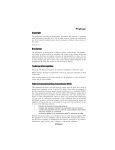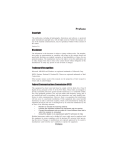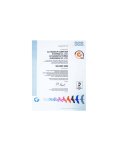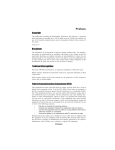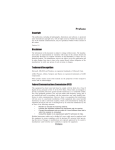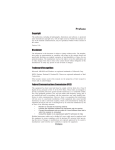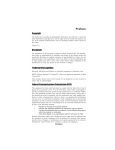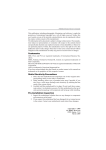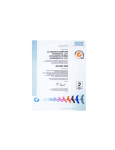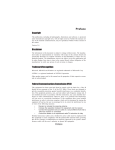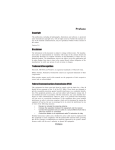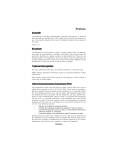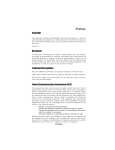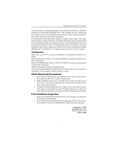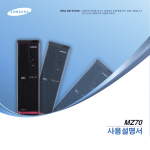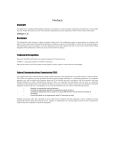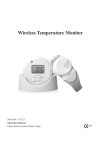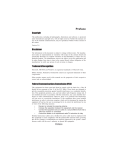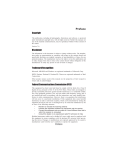Download Elitegroup nForce6M-A
Transcript
Preface Copyright This publication, including all photographs, illustrations and software, is protected under international copyright laws, with all rights reserved. Neither this manual, nor any of the material contained herein, may be reproduced without written consent of the author. Version 6.0 Disclaimer The information in this document is subject to change without notice. The manufacturer makes no representations or warranties with respect to the contents hereof and specifically disclaims any implied warranties of merchantability or fitness for any particular purpose. The manufacturer reserves the right to revise this publication and to make changes from time to time in the content hereof without obligation of the manufacturer to notify any person of such revision or changes. Trademark Recognition Microsoft, MS-DOS and Windows are registered trademarks of Microsoft Corp. AMD, Athlon, Sempron and Duron are registered trademarks of AMD Corporation. Other product names used in this manual are the properties of their respective owners and are acknowledged. Federal Communications Commission (FCC) This equipment has been tested and found to comply with the limits for a Class B digital device, pursuant to Part 15 of the FCC Rules. These limits are designed to provide reasonable protection against harmful interference in a residential installation. This equipment generates, uses, and can radiate radio frequency energy and, if not installed and used in accordance with the instructions, may cause harmful interference to radio communications. However, there is no guarantee that interference will not occur in a particular installation. If this equipment does cause harmful interference to radio or television reception, which can be determined by turning the equipment off and on, the user is encouraged to try to correct the interference by one or more of the following measures: • • • • Reorient or relocate the receiving antenna. Increase the separation between the equipment and the receiver. Connect the equipment onto an outlet on a circuit different from that to which the receiver is connected. Consult the dealer or an experienced radio/TV technician for help. Shielded interconnect cables and a shielded AC power cable must be employed with this equipment to ensure compliance with the pertinent RF emission limits governing this device. Changes or modifications not expressly approved by the system ’ s manufacturer could void the user’s authority to operate the equipment. Preface ii Declaration of Conformity This device complies with part 15 of the FCC rules. Operation is subject to the following conditions: • • This device may not cause harmful interference, and This device must accept any interference received, including interference that may cause undesired operation Canadian Department of Communications This class B digital apparatus meets all requirements of the Canadian Interferencecausing Equipment Regulations. Cet appareil numérique de la classe B respecte toutes les exigences du Réglement sur le matériel brouilieur du Canada. About the Manual The manual consists of the following: Describes features of the motherboard. Go to H page 1 Chapter 1 Introducing the Motherboard Chapter 2 Describes installation of motherboard components. Go to H page 7 Installing the Motherboard Provides information on using the BIOS Setup Utility. Go to H page 27 Chapter 3 Using BIOS Chapter 4 Using the Motherboard Software Chapter 5 Setting Up NVIDIA RAID Configuration Describes the motherboard software Go to H page 47 Provides information about SATA RAID Setup Go to H page 51 Provides basic trouble shooting tips Chapter 6 Trouble Shooting Go to Preface H page 61 iii TABLE OF CONTENTS Preface i Chapter 1 1 Introducing the Motherboard 1 Introduction......................................................................................1 Feature ..............................................................................................2 Motherboard Components.............................................................4 Chapter 2 7 Installing the Motherboard 7 Safety Precautions...........................................................................7 Choosing a Computer Case............................................................7 Installing the Motherboard in a Case............................................7 Checking Jumper Settings...............................................................8 Setting Jumpers...................................................................8 Checking Jumper Settings...................................................9 Jumper Settings...................................................................9 Installing Hardware........................................................................10 Installing the Processor.....................................................10 Installing Memory Modules...............................................11 Expansion Slots.................................................................15 Connecting Optional Devices............................................17 Installing a Hard Disk Drive/CD-ROM/SATA Hard Drive...21 Installing a Floppy Diskette Drive....................................22 Connecting I/O Devices................................................................23 Connecting Case Components.....................................................24 Front Panel Header...........................................................26 Chapter 3 27 Using BIOS 27 About the Setup Utility................................................................ 27 The Standard Configuration............................................27 Entering the Setup Utility..................................................27 Resetting the Default CMOS Values..................................28 Using BIOS......................................................................................29 Standard CMOS Features.................................................30 Advanced Setup.................................................................33 Advanced Chipset Setup....................................................35 iv Integrated Peripherals......................................................36 Power Management Setup.................................................38 PnP/PCI Configurations....................................................40 PC Health Status................................................................40 Frequency/Voltage Control.................................................43 Load Default Settings ........................................................44 Supervisor Password.........................................................44 User Password...................................................................45 Save & Exit Setup................................................................45 Exit Without Saving..............................................................45 Updating the BIOS...............................................................46 Chapter 4 47 Using the Motherboard Software 47 About the Software CD-ROM/DVD-ROM..................................47 Auto-installing under Windows XP/Vista/7...............................47 Running Setup....................................................................48 Manual Installation........................................................................50 Utility Software Reference............................................................50 Chapter 5 51 Setting Up NVIDIA RAID Configuration 51 Setting Up a Non-Bootable RAID Array......................................51 Setting Up a Bootable RAID Array...............................................51 Chapter 6 61 Trouble Shooting 61 Start up problems during assembly............................................61 Start up problems after prolong use..........................................62 Maintenance and care tips..........................................................62 Basic Troubleshooting Flowchart...................................................63 1 Chapter 1 Introducing the Motherboard Introduction Thank you for choosing the NFORCE6M-A motherboard. This motherboard is a high performance, enhanced function motherboard that supports socket for AM3 Phenom™ II/AM3 Athlon™ II/AM3 Sempron™/AMD Phenom™/Athlon™ 64 X2 DualCore/Athlon ™ 64/Sempron ™ processors for high-end business or personal desktop markets. This motherboard is based on NVIDIA® ΜCP61P media and communications processor (MCP) for best desktop platform solution. ΜCP61P is a single-chip, highly integrated, high performance HyperTransport peripheral controller, unmatched by any other single chip-device controller. This motherboard supports up to 32 GB of system memory with DDR2 800/667/533/400. It supports high resolution graphics via one PCI Express x16 slot, and it also integrates native Gigabit Ethernet LAN controller, 8 USB 2.0 ports (4 USB ports and 2 USB headers support additional 4 USB ports) and Serial ATA host controller with maximum transfer rate up to 3.0 Gb/s. There is an advanced full set of I/O ports in the rear panel, including PS/2 mouse and keyboard connectors, COM1, four USB ports, one optional LAN port, one optional ESATA port and audio jacks for microphone, line-in, and 6/8-channel (optional) line-out. Introducing the Motherboard 2 Feature Processor This motherboard uses Sockets AM2+ that carries the following features: • Accommodates AM3 Phenom™ II/AM3 Athlon™ II/AM3 Sempron™/AMD Phenom™/Athlon™ 64 X2 Dual-Core/Athlon™ 64/Sempron™ processors • Supports up to 2000 MT/s HyperTransportTM (HT) interface Speeds HyperTransport TM Technology is a point-to-point link between two devices, it enables integrated circuits to exchange information at much higher speeds than currently available interconnect technologies. This board supports AM3 CPU up to 65W TDP only. Chipset The NVIDIA® MCP61P is a single-chip with proven reliability and performance. • • • • • • HyperTransport x16 up and down links at up to 1.0 GHz to the AM2+ CPUs PCI Express x16 for external graphics PCI 2.3 interface at 33 MHz Four SATA controllers,each with integrated dual PHYs that are capable of operating at 1.5Gb/s and 3.0Gb/s speeds Eight USB 2.0 ports Fast ATA-133 IDE controller Memory • • • DDR2 800/667/533/400 DDR SDRAM with Dual Channel supported Accommodates four unbuffered DIMMs Up to 8 GB per DIMM with maximum memory size up to 32 GB Audio (Optional) • • • • High performance HD Audio CODEC 24-bit resolution with up to 192 KHz sample rates Supports Jack Retasking and Universal Jacks™ +5V Analog Power Supply • • • • High performance HD Audio CODEC Eight Channel (4 DAC pairs and 2 stereo ADCs) with 24-bit resolustion Sample Rates Up to 192 KHz +5V Analog Power Supply Introducing the Motherboard 3 Onboard LAN (Optional) The onboard LAN provides the following features: • • • Integrated Gigabit Ethernet Controller for PCI ExpressTM Applications Integrated 10/100/1000 transceiver Wake-on-LAN and remote wake-up support Expansion Options The motherboard comes with the following expansion options: • One PCI Express x16 for Graphics Interface • One PCI Express x1 slots • Three 32-bit PCI v2.3 compliant slots • One IDE connector supporting up to two IDE devices • One floppy disk drive interface • Four 7-pin SATA connectors This motherboard supports Ultra DMA bus mastering with transfer rates of 133/ 100/66/33 MB/s. Integrated I/O The motherboard has a full set of I/O ports and connectors: • • • • • • Two PS/2 ports for mouse and keyboard One serial port One ESATA port (optional) Four USB ports One LAN port (optional) Audio jacks for microphone, line-in and 6/8-channel (optional) line-out BIOS Firmware The motherboard uses AMI BIOS that enables users to configure many system features including the following: • • • • Power management Wake-up alarms CPU parameters CPU and memory timing The firmware can also be used to set parameters for different processor clock speeds. Some hardware specifications and software items are subject to change without prior notice. Introducing the Motherboard 4 Motherboard Components Introducing the Motherboard 5 Table of Motherboard Components LABEL COMPONENTS AM3 PhenomTM II/AM3 AthlonTM II/AM3 SempronTM/ 1.CPU Socket AMD PhenomTM/AthlonTM 64 X2 Dual-Core/ AthlonTM 64/SempronTM processors 2.CPU_FAN CPU cooling fan connector 3.PWR_FAN* Power Fan connector 4.DDR2_1~4 240-pin DDR2 SDRAM slots 5.ATX_POWER Standard 24-pin ATX power connector 6.IDE Primary IDE connector 7.SATA1~4 Serial ATA connectors 8.SPK Speaker header 9.LPT Onboard Parallel Port header 10.USBPWR_F Front USB Power Select jumper 11.F_PANEL Front panel switch/LED header 12.F_USB1~2 Front Panel USB headers 13.TPM* TPM Module header 14.IRDA* Infrared header 15.FDD Floppy disk drive connector 16.COM2 Onboard serial port header 17.SPDIFO SPDIF out header 18.CD_IN Analog audio input connector 19.F_AUDIO Front panel audio header 20.WOL* Wake On LAN Connector 21.PCI1~3 32-bit add-on card slots 22.PCIE PCI Express x1 slot 23.CLR_CMOS Clear CMOS jumper 24.PCIEX16 PCI Express x16 slot for graphics interface 25.W-USB* USB Wireless Card header 26.SYS_FAN System cooling fan connector 27.USBPWR_R Rear USB Power Select jumper Standard 4-Pin ATX Power connector 28.ATX12V * Stands for optional components This concludes Chapter 1. The next chapter explains how to install the motherboard. Introducing the Motherboard 6 Memo Introducing the Motherboard 7 Chapter 2 Installing the Motherboard Safety Precautions • • • • • Follow these safety precautions when installing the motherboard Wear a grounding strap attached to a grounded device to avoid damage from static electricity Discharge static electricity by touching the metal case of a safely grounded object before working on the motherboard Leave components in the static-proof bags they came in Hold all circuit boards by the edges. Do not bend circuit boards Choosing a Computer Case There are many types of computer cases on the market. The motherboard complies with the specifications for the ATX system case. First, some features on the motherboard are implemented by cabling connectors on the motherboard to indicators and switches on the system case. Make sure that your case supports all the features required. Secondly, this motherboard supports one floppy diskette drive and two enhanced IDE drives. Make sure that your case has sufficient power and space for all drives that you intend to install. Most cases have a choice of I/O templates in the rear panel. Make sure that the I/O template in the case matches the I/O ports installed on the rear edge of the motherboard. This motherboard carries an ATX form factor of 305 X 210 mm. Choose a case that accommodates this form factor. Installing the Motherboard in a Case Refer to the following illustration and instructions for installing the motherboard in a case. Most system cases have mounting brackets installed in the case, which correspond the holes in the motherboard. Place the motherboard over the mounting brackets and secure the motherboard onto the mounting brackets with screws. Ensure that your case has an I/O template that supports the I/O ports and expansion slots on your motherboard. Installing the Motherboard 8 Do not over-tighten the screws as this can stress the motherboard. Checking Jumper Settings This section explains how to set jumpers for correct configuration of the motherboard. Setting Jumpers Use the motherboard jumpers to set system configuration options. Jumpers with more than one pin are numbered. When setting the jumpers, ensure that the jumper caps are placed on the correct pins. The illustrations show a 2-pin jumper. When the jumper cap is placed on both pins, the jumper is SHORT. If you remove the jumper cap, or place the jumper cap on just one pin, the jumper is OPEN. SHORT This illustration shows a 3-pin jumper. Pins 1 and 2 are SHORT. Installing the Motherboard OPEN 9 Checking Jumper Settings The following illustration shows the location of the motherboard jumpers. Pin 1 is labeled. Jumper Settings Jumper Type Description CLR_CMOS 3-pin CLEAR CMOS USBPWR_R 3-pin USB Power Select Jumper Setting (default) 1-2: NORMAL 2-3: CLEAR 1 Before clearing the CMOS, make sure to CLR_CMOS turn the system off. 1-2: VCC5 2-3: VCC5_DUAL 1 USBPWR_R 1 USB Power USBPWR_F 3-pin Select Jumper 1-2: VCC5 2-3: VCC5_DUAL USBPWR_F 1. To avoid the system instability after clearing CMOS, we recommend users to enter the main BIOS setting page to “Load Optimized Defaults” and then “Save & Exit Setup”. 2. Make sure the power supply provides enough VCC5_DUAL voltage before selecting the VCC5_DUAL function. 3. It is required that users place the USBPWR_F & USBPWR_R cap onto 2-3 pin rather than 1-2 pin as default if you want to wake up the computer by USB/PS2 KB/Mouse. Installing the Motherboard 10 Installing Hardware Installing the Processor Caution: When installing a CPU heatsink and cooling fan make sure that you DO NOT scratch the motherboard or any of the surface-mount resistors with the clip of the cooling fan. If the clip of the cooling fan scrapes across the motherboard, you may cause serious damage to the motherboard or its components. On most motherboards, there are small surface-mount resistors near the processor socket, which may be damaged if the cooling fan is carelessly installed. Avoid using cooling fans with sharp edges on the fan casing and the clips. Also, install the cooling fan in a well-lit work area so that you can clearly see the motherboard and processor socket. Before installing the Processor This motherboard automatically determines the CPU clock frequency and system bus frequency for the processor. You may be able to change these settings by changing the settings in the system Setup Utility. We strongly recommend that you do not over-clock processors or other components to run faster than their rated speed. Warning: 1. Over-clocking components can adversely affect the reliability of the system and introduce errors into your system. Over-clocking can permanently damage the motherboard by generating excess heat in components that are run beyond the rated limits. 2. Always remove the AC power by unplugging the power cord from the power outlet before installing or removing the motherboard or other hardware components. This motherboard has Socket AM2+ processor socket. When choosing a processor, consider the performance requirements of the system. Performance is based on the processor design, the clock speed and system bus frequency of the processor, and the quantity of internal cache memory and external cache memory. Installing the Motherboard 11 CPU Installation Procedure The following illustration shows CPU installation components. 1 2 3 4 5 Install your CPU. Pull up the lever away from the socket and lift up to 90-degree angle. Locate the CPU cut edge (the corner with the pin hold noticeably missing). Align and insert the CPU correctly. Press the lever down and apply thermal grease on top of the CPU. Put the CPU Fan down on the retention module and snap the four retention legs of the cooling fan into place. Flip the levers over to lock the heat sink in place and connect the CPU cooling Fan power cable to the CPUFAN connector. This completes the installation. To achieve better airflow rates and heat dissipation, we suggest that you use a high quality fan with 4800 rpm at least. CPU fan and heatsink installation procedures may vary with the type of CPU fan/heatsink supplied. The form and size of fan/heatsink may also vary. Installing Memory Modules This motherboard accommodates four 240-pin unbuffered DIMMs and supports DDR2 800/667/533/400 DDR2 SDRAM. You must install at least one module in any of the four slots. Each module can be installed with 8 GB of memory; the total memory capacity is 32 GB. DDR2 SDRAM memory module table Memory module Memory Bus DDR2 400 DDR2 533 DDR2 667 DDR2 800 200 266 333 400 MHz MHz MHz MHz You must install at least one module in any of the two or four slots. Each module can be installed with 8 GB of memory. Do not remove any memory module from its antistatic packaging until you are ready to install it on the motherboard. Handle the modules only by their edges. Do not touch the components or metal parts. Always wear a grounding strap when you handle the modules. Installing the Motherboard 12 Installation Procedure Refer to the following to install the memory modules. 1 2 3 This motherboard supports unbuffered DDR2 SDRAM only. Push the latches on each side of the DIMM slot down. Align the memory module with the slot. The DIMM slots are keyed with notches and the DIMMs are keyed with cutouts so that they can only be installed correctly. Check that the cutouts on the DIMM module edge connector match the notches in the DIMM slot. Install the DIMM module into the slot and press it firmly down until it seats correctly. The slot latches are levered upwards and latch on to the edges of the DIMM. Install any remaining DIMM modules. 4 5 6 For best performance and compatibility, we recommend that users install DIMMs in the sequence of DIMM3, DIMM4, DIMM1 and DIMM2. Recommend configuration for best performance and compatibility Number of DIMMs DIMM 1 DIMM 2 DIMM 3 DIMM 4 1 2 3 4 AM2 Single Channel AM2+ * Unganged Mode Dual Channel Ganged Mode Single Channel Unganged Mode Dual Channel Ganged Mode * When Unganged Mode is disabled : operation with normal performance : operation with the best performance Installing the Motherboard 13 Table A: DDR2 (memory module) QVL (Qualified Vendor List) The following DDR2 memory modules have been tested and qualified for use with this motherboard. Type DDR2 533 Size Vendor Module Name 512MB Kingston HY5PS12821 F-C4 1GB A-data Vitesta 512 MB Micron MT4HTF6464AY-667E1 Apacer Corsair 1 GB AU01GE667C5KBGC 78.01G9O.9K5 VS1GB667D2 Kingston KVR667D2N5 Micron MT8HTF12864AY-667E1 AL7E8E63B-6E1T DDR2 667 PSC AL7E8F63J-6E1 AL7E8F73C-6E1 Samsung Hynix 2 GB Golden Bar M378T2863DZS 0742 HYMP125U64AP8-Y5 AB-A 0623 Kingston KVR667D2N5/2G LeadMax PC2-5300U Installing the Motherboard 14 Type Size Vendor Module Name A-DATA M2GVD6G3I41P0U1E5E AU01GE800C5KBGC Apacer 78.01GA0.9L5 78.01GA0.9K5 1GB Geil Geil Millenary Hynix HYMP112U64CP8-S6 AB KingMax KLDD48F-B8KU5 NGES Kingston KVR800D2N5/1G 1.8V 9905316- Nanya NT1GT64U88D0BY-AD 054.A01LF Ramaxel Samsung Silicon Power DDR2 800 SP001GBLRU800S01 DIMM 5-5-5 Unifosa GU341G0ALEPR6B2C6CE A-DATA Red A-DATA M2OMI6H3J4720L1C5Z 78.A1GC0.9L4 78.A1GAO.9K4 CORSAIR CM2X2048-6400C5 Geil Geil Platinum Edition Hynix HYMP125U64CP8-S6 AB KingMax KLDE88F-B8KU5 NHES Kingston KVR800D2N5/2G KVR800D2N6/2G-SP Micron MT16HTF25664AY-800E1 Nanya NT2GT64U8HD0BY-AD PSC AL8E8F73C-8E1 Samsung DDR2 1066 M378T2863EHS-CF7 0849 Transcend Apacer 2 GB RML1320EH38D7F-800 Golden Bar M378T2953EZ3-CE7 0726 M378T5663QZ3-CF7 M378T5663EH3-CF7 Silicon Power SP002GBLRU800S01 Unifosa GU342G0ALEPR692C6CE 4 GB Samsung M378T5263AZ3-CF7 0819 1GB Micron MT8HTF12864AY-1GAE1 2GB Micron MT16HTF25664AY-1GAE1 Installing the Motherboard 15 Expansion Slots Installing Add-on Cards The slots on this motherboard are designed to hold expansion cards and connect them to the system bus. Expansion slots are a means of adding or enhancing the motherboard’s features and capabilities. With these efficient facilities, you can increase the motherboard’s capabilities by adding hardware that performs tasks that are not part of the basic system. PCIEX16 Slot The PCI Express x16 slot is used to install an external PCI Express graphics card that is fully compliant to the PCI Express Base Specification revision 1.1. PCIE Slot The PCI Express x1 slot is fully compliant to the PCI Express Base Specification revision 1.1 as well. PCI1~3 Slots This motherboard is equipped with three standard PCI slots. PCI stands for Peripheral Component Interconnect and is a bus standard for expansion cards, which for the most part, is a supplement of the older ISA bus standard. The PCI slots on this board are PCI v2.3 compliant. Before installing an add-on card, check the documentation for the card carefully. If the card is not Plug and Play, you may have to manually configure the card before installation. Installing the Motherboard 16 Follow these instructions to install an add-on card: 1 2 3 Remove a blanking plate from the system case corresponding to the slot you are going to use. Install the edge connector of the add-on card into the expansion slot. Ensure that the edge connector is correctly seated in the slot. Secure the metal bracket of the card to the system case with a screw. For some add-on cards, for example graphics adapters and network adapters, you have to install drivers and software before you can begin using the add-on card. Installing the Motherboard 17 Connecting Optional Devices Refer to the following for information on connecting the motherboard’s optional devices: F_AUDIO: Front Panel Audio header (Optional) This header allows the user to install auxiliary front-oriented microphone and 6/8Pin forSignal channel (optional) line-out ports easier Name access. Pin 1 3 5 7 9 Signal Name Pin Signal Name PORT 1L 2 AUD_GND PORT 1R 4 PRESENCE# PORT 2R 6 SENSE1_RETURN SENSE_SEND 8 10 KEY PORT 2L SENSE2_RETURN SATA1~4: Serial ATA connectors These connectors are used to support the new Serial ATA devices for the highest date transfer rates (1.5/3.0 Gb/s), simpler disk drive cabling and easier PC assembly. It eliminates limitations of the current Parallel ATA interface. But maintains register compatibility and software compatibility with Parallel ATA. Pin 1 3 5 7 Signal Name Pin Ground 2 4 6 - TXRXGround Signal Name TX+ Ground RX+ - Installing the Motherboard 18 F_USB1~2: Front Panel USB headers The motherboard has four USB ports installed on the rear edge I/O port array. Additionally, some computer cases have USB ports at the front of the case. If you have this kind of case, use auxiliary USB connector to connect the front-mounted ports to the motherboard. Pin Signal Name Function 1 2 3 4 5 6 7 USBPWR Front Panel USB Power USBPWR Front Panel USB Power USB_FP_P0- USB Port 0 Negative Signal USB_FP_P1- USB Port 1 Negative Signal USB_FP_P0+ USB Port 0 Positive Signal USB_FP_P1+ USB Port 1 Positive Signal GND Ground 8 9 10 GND Ground Key No pin NC Not connected Please make sure that the USB cable has the same pin assignment as indicated above. A different pin assignment may cause damage or system hang-up. IRDA: Infrared port (Optional) The motherboard supports an Infrared (IRDA) data port. Infrared ports allow the wireless exchange of information between your computer and similarly equipped devices such as printers, laptops, Personal Digital Assistants (PDAs), and other computers. Pin Pin SignalName Name Signal Function Function 1 2 3 Not assigned KEY +5V IR Power 4 5 6 GND Ground Not assigned No pin IRTX IrDA serial output IRRX IrDA serial input CD_IN: Analog Audio Input header Pin Signal Name 1 2 3 4 CD_Right CD In right channel CD_GND Ground CD_GND Ground CD _Left CD In left channel Function Installing the Motherboard 19 TPM: TPM Module Header (Optional) Trusted Platform Module (TPM) is a published specification detailing a microcontroller that can store secured information, and implementations of that specification. Pin Signal Name Pin Signal Name LAD0 LAD2 11 12 13 14 15 16 17 18 VCC3 19 LPCPD# 20 RESERVE2 1 2 3 4 5 6 7 8 TPM_CLK 9 10 LAD1 GND LFRAME# KEY LREST# VCC5 LAD3 GND RESERVE0 RESERVE1 VCC3_DUAL SERIRQ GND CLKRUN# W-USB: USB Wireless Card Header (Optional) This is a header that will preserve the functionality of wired USB while also unwiring the cable connection and providing enhanced support for streaming media CE devices and peripherals. Pin Signal Name 1 2 3 4 5 6 USB Power USB Power USBPAUSBPBUSBPA+ USBPB+ Pin Signal Name 7 8 9 10 11 12 GND GND KEY USBOC# PME# VCC3_DUAL SPDIFO: SPDIF out header This is a header that provides an S/PDIF (Sony/Philips Digital Interface) output to digital multimedia device through optical fiber or coaxial connector. Pin 1 2 3 4 Signal Name Function SPDIF SPDIF digital output +5VA 5V analog Power Key No pin GND Ground Installing the Motherboard 20 LPT: Onboard parallel port header This is a header that can be used to connect to the printer, scanner or other devices. Pin Signal Name Pin 1 2 3 4 5 6 7 8 9 10 11 12 13 STROBE 14 15 16 17 18 19 20 21 22 23 24 25 26 PD0 PD1 PD2 PD3 PD4 PD5 PD6 PD7 ACK BUSK PE SLCT Signal Name ALF ERROR INIT SLCTIN Ground Ground Ground Ground Ground Ground Ground Ground Key COM2: Onboard serial port header Connect a serial port extension bracket to this header to add a second serial port to your system. Pin Signal Name Function 1 DCDB Data carry detect 2 3 4 5 6 7 NSINB Serial Data In NSOUTB Serial Data Out DTRB Data terminal ready GND Ground DSRB Date set ready RTSB Request to send 8 9 10 CTSB Clear to send RI Ring Indicator Key No pin WOL: Wake On LAN connector (Optional) If you have installed a LAN card, use the cable provided with the card to plug into the WOL1 connector onboard. This enables the Wake On LAN (WOL) feature. When your system is in a power-saving mode, any LAN signal automatically resumes the system. You must enable this item using the Power Management page of the Setup Utility in the BIOS. See Chapter 3 for more information. Pin Signal Name Function 1 5VSB 2 GND Ground 3 Wake_up Wake up signal (low active) +5V stand by power Installing the Motherboard 21 Installing a Hard Disk Drive/CD-ROM/SATA Hard Drive This section describes how to install IDE devices such as a hard disk drive and a CDROM drive. About IDE Devices Your motherboard has one IDE channel interface. IDE: IDE Connector This motherboard supports two or four high data transfer SATA ports with each runs up to 1.5/3.0 Gb/s. To get better system performance, we recommend users connect the CD-ROM to the IDE channel, and set up the hard drives on the SATA ports. IDE devices enclose jumpers or switches used to set the IDE device as MASTER or SLAVE. Refer to the IDE device user’s manual. Installing two IDE devices on one cable, ensure that one device is set to MASTER and the other device is set to SLAVE. The documentation of your IDE device explains how to do this. About SATA Connectors Your motherboard features two or four SATA connectors supporting a total of two or four drives. SATA refers to Serial ATA (Advanced Technology Attachment) is the standard interface for the IDE hard drives which are currently used in most PCs. These connectors are well designed and will only fit in one orientation. Locate the SATA connectors on the motherboard and follow the illustration below to install the SATA hard drives. Installing Serial ATA Hard Drives To install the Serial ATA (SATA) hard drives, use the SATA cable that supports the Serial ATA protocol. This SATA cable comes with an SATA power cable. You can connect either end of the SATA cable to the SATA hard drive or the connector on the motherboard. SATA cable (optional) SATA power cable Installing the Motherboard (optional) 22 Refer to 1 2 3 the illustration below for proper installation: Attach either cable end to the connector on the motherboard. Attach the other cable end to the SATA hard drive. Attach the SATA power cable to the SATA hard drive and connect the other end to the power supply. This motherboard supports the “ Hot-Plug“ function. Installing a Floppy Diskette Drive FDD: Floppy Disk Connector Connect the single end of the floppy connector to the onboard floppy connector firstly, and then connect the remaining plug on the other end to the floppy drive correspondingly. You must orient the cable connector so that the pin 1 (color) edge of the cable corresponds to the pin 1 of the I/O port connector. Installing the Motherboard 23 Connecting I/O Devices The backplane of the motherboard has the following I/O ports: PS2 Mouse Use the upper PS/2 port to connect a PS/2 pointing device. PS2 Keyboard Use the lower PS/2 port to connect a PS/2 keyboard. ESATA Port Use this port to connect to an external SATA box or a (Optional) Serial ATA portmultiplier . Serial Port (COM1) Use the COM port to connect serial devices such as mice or fax/modems. LAN Port (Optional) Connect an RJ-45 jack to the LAN port to connect your computer to the Network. USB Ports Use the USB ports to connect USB devices. Audio Ports (Optional) Use the three audio ports to connect audio devices. The first jack is for stereo line-in signal. The second jack is for stereo line-out signal. The third jack is for microphone. This motherboard may adopt 8-channel audio ports that correspond to the A,B, C, and E port respectively. In addition, all of the 3 ports, B, C, and E provide users with both right & left channels individually. Users please refer to the following note for specific port function definition. A: Center & Woofer B: Back Surround C: Side Surround D: Line-in E: Front Out F: Mic_in Rear The above port definition can be changed to audio input or audio output by changing the driver utility setting. Installing the Motherboard 24 Connecting Case Components After you have installed the motherboard into a case, you can begin connecting the motherboard components. Refer to the following: 1 2 3 4 5 6 7 Connect the CPU cooling fan cable to CPU_FAN. Connect the power cooling fan connector to PWR_FAN (optional). Connect the system cooling fan connector to SYS_FAN. Connect the case speaker cable to SPK. Connect the standard power supply connector to ATX_POWER. Connect the auxiliary case power supply connector to ATX12V. Connect the case switches and indicator LEDs to the F_PANEL. Connecting 24-pin power cable Users please note that the 24-pin power cable can be connected to the ATX_POWER connector. With ATX v2.x power supply, users please note that when installing 24-pin power cable, the latches of power cable and the ATX_POWER match perfectly. 24-pin power cable Connecting 4-pin power cable The ATX12V power connector is used to provide power to the CPU. When installing 4-pin power cable, the latches of power cable and the ATX12V match perfectly. 4-pin power cable Installing the Motherboard 25 CPU_FAN: CPU Cooling FAN Power Connector Pin Signal Name Function 1 2 3 Ground System Ground +12V Power +12V SENSE Sensor 4 CONTROL CPU FAN control Users please note that the fan connector supports the CPU cooling fan of 1.1A~2.2A (26.4W max.) at +12V. PWR_FAN (optional)/SYS_FAN: Cooling FAN Power Connectors Pin Signal Name Function 1 GND 2 3 +12V Power +12V Sense Sensor System Ground SPK: Internal speaker Pin 1 2 3 4 Signal Name VCC Key GND Signal ATX_POWER: ATX 24-pin Power Connector Pin Signal Name 1 2 3 4 5 6 7 8 9 +3.3V 10 11 12 +12V +3.3V COM +5V COM +5V COM PWR OK 5VSB Pin 13 14 15 16 17 18 19 20 21 22 23 24 +12V +3.3V Signal Name +3.3V -12V COM PS_ON COM COM COM -5V +5V +5V +5V COM ATX12V: ATX 12V Power Connector Pin 1 2 3 4 Signal Name Ground Ground +12V +12V Installing the Motherboard 26 Front Panel Header The front panel header (F_PANEL) provides a standard set of switch and LED headers commonly found on ATX or Micro ATX cases. Refer to the table below for information: Pin Signal Name 1 Function Pin Signal Name HD_LED_P Hard disk LED(+) 2 FP PWR/SLP 3 HD_LED_N Hard disk LED(-) 4 5 RST_SW_N 7 9 Function *MSG LED(+) FP PWR/SLP *MSG LED(-) Reset Switch(-) 6 PWR_SW_N Power Switch(-) RST_SW_P Reset Switch(+) 8 PWR_SW_P Power Switch(+) RSVD Reserved 10 Key No pin * MSG LED (dual color or single color) Hard Drive Activity LED Connecting pins 1 and 3 to a front panel mounted LED provides visual indication that data is being read from or written to the hard drive. For the LED to function properly, an IDE drive should be connected to the onboard IDE interface. The LED will also show activity for devices connected to the SCSI (hard drive activity LED) connector. Power/Sleep/Message waiting LED Connecting pins 2 and 4 to a single or dual-color, front panel mounted LED provides power on/off, sleep, and message waiting indication. Reset Switch Supporting the reset function requires connecting pin 5 and 7 to a momentarycontact switch that is normally open. When the switch is closed, the board resets and runs POST. Power Switch Supporting the power on/off function requires connecting pins 6 and 8 to a momentary-contact switch that is normally open. The switch should maintain contact for at least 50 ms to signal the power supply to switch on or off. The time requirement is due to internal de-bounce circuitry. After receiving a power on/off signal, at least two seconds elapses before the power supply recognizes another on/off signal. This concludes Chapter 2. The next chapter covers the BIOS. Installing the Motherboard 27 Chapter 3 Using BIOS About the Setup Utility The computer uses the latest “American Megatrends Inc.” BIOS with support for Windows Plug and Play. The CMOS chip on the motherboard contains the ROM setup instructions for configuring the motherboard BIOS. The BIOS (Basic Input and Output System) Setup Utility displays the system ’ s configuration status and provides you with options to set system parameters. The parameters are stored in battery-backed-up CMOS RAM that saves this information when the power is turned off. When the system is turned back on, the system is configured with the values you stored in CMOS. The BIOS Setup Utility enables you to configure: • • • • Hard drives, diskette drives and peripherals Video display type and display options Password protection from unauthorized use Power Management features The settings made in the Setup Utility affect how the computer performs. Before using the Setup Utility, ensure that you understand the Setup Utility options. This chapter provides explanations for Setup Utility options. The Standard Configuration A standard configuration has already been set in the Setup Utility. However, we recommend that you read this chapter in case you need to make any changes in the future. This Setup Utility should be used: • • • • • when changing the system configuration when a configuration error is detected and you are prompted to make changes to the Setup Utility when trying to resolve IRQ conflicts when making changes to the Power Management configuration when changing the password or making other changes to the Security Setup Entering the Setup Utility When you power on the system, BIOS enters the Power-On Self Test (POST) routines. POST is a series of built-in diagnostics performed by the BIOS. After the POST routines are completed, the following message appears: Press DEL to enter SETUP Using BIOS 28 Press the delete key to access the BIOS Setup Utility. CMOS Setup Utility -- Copyright (C) 1985-2005, American Megatrends, Inc. f Standard CMOS Setup f Advanced Setup f Advanced Chipset Setup f Integrated Peripherals f Power Management Setup f PCI/PnP Setup f PC Health Status fFrequency/Voltage Control Load Default Settings fSupervisor Password fUser Password Save & Exit Setup Exit Without Saving mnlk : Move Enter : Select +/-/: Value F10: Save F1:General Help F9: Optimized Defaults ESC: Exit v02.67 (C)Copyright 1985-2009, American Mega trends, Inc. Resetting the Default CMOS Values When powering on for the first time, the POST screen may show a “CMOS Settings Wrong” message. This standard message will appear following a clear CMOS data at factory by the manufacturer. You simply need to Load Default Settings to reset the default CMOS values. Note: Changes to system hardware such as different CPU, memories, etc. may also trigger this message. Using BIOS 29 Using BIOS When you start the Setup Utility, the main menu appears. The main menu of the Setup Utility displays a list of the options that are available. A highlight indicates which option is currently selected. Use the cursor arrow keys to move the highlight to other options. When an option is highlighted, execute the option by pressing <Enter>. Some options lead to pop-up dialog boxes that prompt you to verify that you wish to execute that option. Other options lead to dialog boxes that prompt you for information. Some options (marked with a triangle f ) lead to submenus that enable you to change the values for the option. Use the cursor arrow keys to scroll through the items in the submenu. In this manual, default values are enclosed in parenthesis. Submenu items are denoted by a triangle f . The default BIOS setting for this motherboard apply for most conditions with optimum performance. We do not suggest users change the default values in the BIOS setup and take no responsibility to any damage caused by changing the BIOS settings. BIOS Navigation Keys The BIOS navigation keys are listed below: KEY ESC mnlk FUNCTION Exits the current menu Scrolls through the items on a menu +/Enter Modifies the selected field’s values Select F9 Loads an optimized setting for better performance F10 Saves the current configuration and exits setup F1 Displays a screen that describes all key functions Using BIOS 30 For the purpose of better product maintenances, we reserve the right to change the BIOS items presented in the manual. The BIOS setup screens shown in this chapter are for reference only. Please visit our website for updated manual. Standard CMOS Setup This option displays basic information about your system. CMOS Setup Utility -- Copyright (C) 1985-2005, American Megatrends, Inc. Standard CMOS Setup Date Time f f f f f f Tue 07/28/2009 00 : 12 : 01 Primary IDE Master Primary IDE Slave SATA 1 SATA 2 SATA 3 SATA 4 Not Detected Not Detected Not Detected Not Detected Not Detected Not Detected IDE BusMaster Enabled Drive A: 1.44 MB 31/2” Help Item User [Enter], [TAB] or [SHIFT-TAB] to select a field. Use [+] or [-] to configure system Date. mnlk: Move Enter : Select +/-/: Value F10: Save ESC: Exit F1: General Help F9: Optimized Defaults Date & Time The Date and Time items show the current date and time on the computer. If you are running a Windows OS, these items are automatically updated whenever you make changes to the Windows Date and Time Properties utility. Using BIOS 31 f Primary IDE Master/Slave, SATA 1~4 Your computer has one IDE channel which can be installed with one or two devices (Master and Slave). In addition, this motherboard supports four SATA channels and each channel allows one SATA device to be installed. Use these items to configure each device on the IDE channel. CMOS SETUP UTILITY – Copyright (C) 1985-2005, American Megatrends, Inc. Primary IDE Master Help Item Primary IDE Master Device : Not Detected Type LBA/Large Mode Block (Multi-Sector Transfer PIO Mode DMA Mode S.M.A.R.T. 32Bit Data Transfer Auto Auto Auto Auto Auto Auto Enabled Select the type of device connected to the system. mnlk: Move Enter : Select +/-/: Value F10: Save ESC: Exit F1: General Help F9: Optimized Defaults Type (Auto) Use this item to configure the type of the IDE device that you specify. If the feature is enabled, it will enhance hard disk performance by reading or writing more data during each transfer. LBA/Large Mode (Auto) Use this item to set the LAB/Large mode to enhance hard disk performance by optimizing the area the hard disk is visited each time. Block (Multi-Sector Transfer) (Auto) If the feature is enabled, it will enhance hard disk performance by reading or writing more data during each transfer. PIO Mode (Auto) Use this item to set the PIO mode to enhance hard disk performance by optimizing the hard disk timing. DMA Mode (Auto) DMA capability allows user to improve the transfer-speed and data-integrity for compatible IDE devices. S.M.A.R.T. (Auto) The S.M.A.R.T. (Self-Monitoring, Analysis and Reporting Technology) system is a diagnostics technology that monitors and predicts device performance. S.M.A.R.T. software resides on both the disk drive and the host computer. 32Bit Data Transfer (Enabled) Use this item to enable or disable the 32Bit Data Transfer. Press <Esc> to return to the Standard CMOS Setup page. Using BIOS 32 IDE BusMaster (Enabled) This item enables or disables the DMA under DOS mode. We recommend you to leave this item at the default value. Drive A (1..44 MB 31/2”) This item defines the characteristics of any diskette drive attached to the system. Only one diskette drive is supported. Press <Esc> to return to the main menu setting page. Using BIOS 33 Advanced Setup This page sets up more advanced information about your system. Handle this page with caution. Any changes can affect the operation of your computer. CMOS Setup Utility - Copyright (C) 1985-2005, American Megatrends, Inc. Advanced Setup HT Frequency AMD C&Q Quick Power on Self Test Boot Up Numlock Status APIC Mode 1st Boot Device 2nd Boot Device 3rd Boot Device fHard Disk Drives f Removable Drives Boot Other Device Auto Enabled Enabled On Enabled USB Flash Disk CD/DVD 1st FLOPPY DRIVE Press Enter Press Enter Yes Help Item MCP61 (SB) to K8(CPU) frequency selection by CPU capability mnlk: Move Enter : Select +/-/: Value F10: Save ESC: Exit F1:General Help F9: Optimized Defaults HT Frequency (Auto) This item enables users to manually set up the HyperTransport frequency. If Manual, the HT Frequency Value will display, and the options are 200 MHz, 400 MHz, 600 MHz, 800 MHz and 1000 MHz. AMD C&Q (Enabled) This item helps the system to lower the frequency when CPU idles. When the frequency decreases, the temperature will drop automatically as well. Quick Power on Self Test (Enabled) Enable this item to shorten the power on testing (POST) and have your system start up faster. You might like to enable this item after you are confident that your system hardware is operating smoothly. Boot Up Numlock Status (On) This item defines if the keyboard Num Lock key is active when your system is started. APIC Mode (Enabled) This item allows you to enable or disable the APCI (Advanced Programmable Interrupt Controller) mode. APIC provides symmetric multi-processing (SMP) for systems, allowing support for up to 60 processors. 1st/2nd/3rd Boot Device (USB Flash Disk/CD/DVD/1st FLOPPY DRIVE) Use this item to determine the device order the computer used to look for an operating system to load at start-up time. The devices showed here will be different depending on the exact devices installed on your motherboard. Using BIOS 34 fHard Disk Drives (Press Enter) Scroll to this item and press <Enter> to view the following screen: CMOS Setup Utility - Copyright (C) 1985-2005, American Megatrends, Inc. Hard Disk Drives Help Item Hard Disk Drives 1st Drive 2nd Drive ST31500341AS USB Flash Disk Specifies the boot sequence from the available devices. mnlk: Move Enter : Select +/-/: Value F10: Save ESC: Exit F1:General Help F9: Optimized Defaults Press <Esc> to return to the Advanced setup page. f Removable Drives (Press Enter) Scroll to this item and press <Enter> to view the following screen: CMOS Setup Utility - Copyright (C) 1985-2005, American Megatrends, Inc. Removable Drives Removable Drives Help Item 1st Drive 1st FLOPPY DRIVE Specifies the boot sequence from the available devices. mnlk: Move Enter : Select +/-/: Value F10: Save ESC: Exit F1:General Help F9: Optimized Defaults Press <Esc> to return to the Advanced setup page. Boot Other Device (Yes) When enabled, the system searches all other possible locations for an operating system if it fails to find one in the devices specified under the First, Second, and Third boot devices. Press <Esc> to return to the main menu setting page. Using BIOS 35 Advanced Chipset Setup This page sets up more advanced information about your system. Handle this page with caution. Any changes can affect the operation of your computer. CMOS Setup Utility - Copyright (C) 1985-2005, American Megatrends, Inc. Advanced Chipset Setup Help Item Dram Frequency Dram Timing DCT Unganged Mode Auto Auto Always Options Auto Limit Manual mnlk: Move Enter : Select +/-/: Value F10: Save ESC: Exit F1:General Help F9: Optimized Defaults Dram Frequency (Auto) This item enables users to adjust the DRAM frequency. The default setting is auto and we recommend users leave the setting unchanged. Modify it at will may cause the system to be unstable. DRAM Timing (Auto) This item allows you to enable or disable the DRAM timing defined by the Serial Presence Detect electrical. Users please note that if setting this item to auto, the following two items are not available. DCT Unganged Mode (Always) This item is used to select the DCT mode (DRAM Controller mode). Using BIOS 36 Integrated Peripherals This page sets up some parameters for peripheral devices connected to the system. CMOS Setup Utility - Copyright (C) 1985-2005, American Megatrends, Inc. Integrated Peripherals Onboard IDE Controller Serial-ATA 0 SATA Configuration Enabled Enabled SATA Mode f nVidia RAID Setup Press Enter Onboard AUDIO Function OnBoard LAN Function OnBoard LAN Boot ROM Serial Port1 Address Serial Port2 Address Parallel Port Address Parallel Port Mode ECP Mode DMA Channel Parallel Port IRQ USB Functions Legacy USB Support Enabled Enabled Disabled 3F8/IRQ4 2F8/IRQ3 378 ECP DMA3 IRQ7 Enabled Enabled Help Item DISABLED: disables the integrated IDE Controller. PRIMARY: enables only the Primary IDE Controller. SECONDARY: enables only the Secondary IDE Controller. BOTH: enables both IDE Controllers. mnlk: Move Enter : Select +/-/: Value F10: Save ESC: Exit F1:General Help F9: Optimized Defaults Onboard IDE Controller (Enabled) Use this item to enable or disable the onboard IDE interface. Serial-ATA 0 (Enabled) This item allows you to enable or disable the onboard SATA controller. SATA Configuration (SATA Mode) Use this item to show the mode of the Serial ATA configuration options. X nVidia RAID Setup (Press Enter) Scroll to this item and press <Enter> to view the following screen: CMOS Setup Utility - Copyright (C) 1985-2005, American Megatrends, Inc. nVidia RAID Setup Help Item RAID Setup mnlk: Move Enter : Select +/-/: Value F10: Save ESC: Exit F1:General Help F9: Optimized Defaults Press <Esc> to return to the Integrated Peripherals page. Using BIOS 37 Onboard AUDIO Function (Enabled) Use this item to enable or disable the onboard audio device. OnBoard LAN Function (Enabled) Use this item to enable or disable the onboard LAN function. OnBoard LAN Boot ROM (Disabled) Use this item to enable or disable the booting from the onboard LAN or a network add-in card with a remote boot ROM installed. Serial Port1/2 Address (3F8/IRQ4/2F8/IRQ3) Use this item to enable or disable the onboard COM1 serial port, and to assign a port address. Parallel Port Address (378) Use this item to enable or disable the onboard Parallel port, and to assign a port address. Parallel Port Mode (ECP) Use this item to select the parallel port mode. You can select Normal (Standard Parallel Port), ECP (Extended Capabilities Port), EPP (Enhanced Parallel Port), or BPP (Bi-Directional Parallel Port). ECP Mode DMA Channel (DMA3) Use this item to assign the DMA Channel under ECP Mode function. Parallel Port IRQ (IRQ7) Use this item to assign IRQ to the parallel port. USB Functions (Enabled) Use this item to enable or disable the USB function. Legacy USB Support (Enabled) Use this item to enable or disable support for legacy USB devices. Setting to Auto allows the system to detect the presence of USB device at startup. If detected, the USB controller legacy mode is enabled. If no USB device is detected, the legacy USB support is disabled. Press <Esc> to return to the main menu setting page. Using BIOS 38 Power Management Setup This page sets up some parameters for system power management operation. CMOS Setup Utility - Copyright (C) 1985-2005, American Megatrends, Inc. Power Management Setup ACPI Suspend Type PWRON After PWR-Fail Resume By Ring Resume By PCI/PCI-E/Lan PME Resume By USB (S3) Resume By PS2 KB (S3) Resume By PS2 MS (S3) Resume on RTC Alarm S3 (STR) Power Off Disabled Disabled Disabled Disabled Disabled Disabled mnlk: Move Enter : Select +/-/: Value F10: Save F9: Optimized Defaults F1:General Help Help Item Select the ACPI state used for System Suspend. ESC: Exit ACPI Suspend Type (S3(STR)) Use this item to define how your system suspends. In the default, S3, the suspend mode is a suspend to RAM, i.e, the system shuts down with the exception of a refresh current to the system memory. PWRON After PWR-Fail (Power Off) This item enables your computer to automatically restart or return to its operating status. Resume By Ring (Disabled) An input signal on the serial Ring Indicator (RI) line (in other words, an incoming call on the modem) awakens the system from a soft off state. Resume by PCI/PCI-E/Lan PME (Disabled) These items specify whether the system will be awakened from power saving modes when activity or input signal of the specified hardware peripheral or component is detected. Resume By USB (S3) (Disabled) This item allows you to enable/disable the USB device wakeup function from S3 mode. Resume By PS2 KB (S3) (Disabled) This item enable or disable you to allow keyboard activity to awaken the system from power saving mode. Resume By PS2 MS (S3) (Disabled) This item enable or disable you to allow mouse activity to awaken the system from power saving mode. Using BIOS 39 Resume By RTC Alarm (Disabled) The system can be turned off with a software command. If you enable this item, the system can automatically resume at a fixed time based on the system’s RTC (realtime clock). Use the items below this one to set the date and time of the wake-up alarm. You must use an ATX power supply in order to use this feature. Press <Esc> to return to the main menu setting page. Using BIOS 40 PCI / PnP Setup This page sets up some parameters for devices installed on the PCI bus and those utilizing the system plug and play capability. CMOS Setup Utility - Copyright (C) 1985-2005, American Megatrends, Inc. PCI / PnP Setup Init Display First PCI Help Item Options PCI PCI Express mnlk: Move Enter : Select +/-/: Value F10: Save ESC: Exit F1:General Help F9: Optimized Defaults Init Display First (PCI) Use this item to select which graphics controller to use as the primary boot devices. Press <Esc> to return to the main menu setting page. PC Health Status On motherboards support hardware monitoring, this item lets you monitor the parameters for critical voltages, temperatures and fan speeds. CMOS Setup Utility - Copyright (C) 1985-2005, American Megatrends, Inc. PC Health Status -=- System Hardware Monitor-=- f Smart Fan Function Shutdown Temperature CPU Tcontrol System Temperature CPU Fan Speed CPU Vcore VDIMM Help Item Press Enter Disabled :40°C/104°F :32°C/89°F :0 RPM :1.304V :1.488V mnlk: Move Enter : Select +/-/: Value F10: Save ESC: Exit F1:General Help F9: Optimized Defaults Using BIOS 41 f Smart Fan Function Scroll to this item and press <Enter> to view the following screen: CMOS Setup Utility - Copyright (C) 1985-2005, American Megatrends, Inc. Smart Fan Function Help Item CPU SMART Fan Control Smart Fan Mode TargetTemp Value Tolerance StartUp Value Stop Value StopTime Value Enabled Normal 040 03 102 051 Options Normal Quiet Silent Manual mnlk : Move Enter : Select F1:General Help Normal: auto adjusts depending on the CPU temperature. Quiet: auto minimizes fan speed for quiet environment operation. +/-/: Value F10: Save ESC: Exit F9: Optimized Defaults SMART Fan Mode (Normal) This item allows you to select the fan mode (Normal, Quiet, Silent, or Manual) for a better operation environment. If you choose Normal mode, the fan speed will be auto adjusted depending on the CPU temperature. If you choose Quite mode, the fan speed will be auto minimized for quiet environment. If you choose Silent mode, the fan speed will be auto restricted to make system more quietly. If you choose Manual mode, the fan speed will be adjust depending on users’ parameters. CMOS Setup Utility - Copyright (C) 1985-2005, American Megatrends, Inc. Smart Fan Function Help Item CPU SMART Fan Control Smart Fan Mode TargetTemp Value Tolerance StartUp Value Stop Value StopTime Value mnlk Enabled Quiet 060 03 076 038 020 : Move Enter : Select F1:General Help Options Normal: auto adjusts depending on the CPU temperature. Quiet: auto minimizes fan speed for quiet environment operation. +/-/: Value F10: Save ESC: Exit F9: Optimized Defaults Press <Esc> to return to the Smart Fan Function page. Using BIOS 42 CMOS Setup Utility - Copyright (C) 1985-2005, American Megatrends, Inc. Smart Fan Function Help Item CPU SMART Fan Control Smart Fan Mode TargetTemp Value Tolerance StartUp Value Stop Value StopTime Value Enabled Silent 065 03 051 030 020 Options Normal: auto adjusts depending on the CPU temperature. Quiet: auto minimizes fan speed for quiet environment operation. mnlk : Move Enter : Select F1:General Help +/-/: Value F10: Save ESC: Exit F9: Optimized Defaults Press <Esc> to return to the Smart Fan Function page. CMOS Setup Utility - Copyright (C) 1985-2005, American Megatrends, Inc. Smart Fan Function Help Item CPU SMART Fan Control Smart Fan Mode TargetTemp Value Tolerance Value StartUp Value Stop Value StopTime Value Enabled Manual 065 03 051 030 020 Options Normal: auto adjusts depending on the CPU temperature. Quiet: auto minimizes fan speed for quiet environment operation. mnlk : Move Enter : Select F1:General Help +/-/: Value F10: Save ESC: Exit F9: Optimized Defaults Press <Esc> to return to the PC Health Status page. Using BIOS 43 System Component Characteristics These items display the monitoring of the overall inboard hardware health events, such as System & CPU temperature, CPU & DIMM voltage, CPU & system fan speed,...etc. • • • • • CPU Tcontrol System Temperature CPU Fan Speed CPU Vcore VDIMM Press <Esc> to return to the main menu setting page. Frequency/Voltage Control This page enables you to set the clock speed and system bus for your system. The clock speed and system bus are determined by the kind of processor you have installed in your system. CMOS Setup Utility - Copyright (C) 1985-2005, American Megatrends, Inc. Frequency/Voltage Control Auto Detect DIMM/PCI CIK Spread Spectrum Help Item Enabled Enabled Options Disabled Enabled mnlk: Move Enter : Select +/-/: Value F10: Save ESC: Exit F1:General Help F9: Optimized Defaults Auto Detect DIMM/PCI Clk (Enabled) When this item is enabled, BIOS will disable the clock signal of free DIMM/PCI slots. Spread Spectrum (Enabled) If you enable spread spertrum, it can significantly reduce the EMI (Electro-Magnetic interface) generated by the system.and voltage according to its temperature. Press <Esc> to return to the main menu setting page. Using BIOS 44 Load Default Settings This option opens a dialog box to ask if you are sure to install optimized defaults or not. You select [OK], and then <Enter>, the Setup Utility loads all default values; or select [Cancel], and then <Enter>, the Setup Utility does not load default values. Supervisor Password This page helps you install or change a password. CMOS Setup Utility - Copyright (C) 1985-2005, American Megatrends, Inc. Supervisor Password Supervisor Password Help Item :Not Installed Change Supervisor Password Press Enter Install or Change the password. mnlk: Move Enter : Select +/-/: Value F10: Save ESC: Exit F1:General Help F9: Optimized Defaults Supervisor Password (Not Installed) This item indicates whether a supervisor password has been set. If the password has been installed, Installed displays. If not, Not Installed displays. Change Supervisor Password (Press Enter) You can select this option and press <Enter> to access the sub menu. You can use the sub menu to change the supervisor password. Press <Esc> to return to the main menu setting page. Using BIOS 45 User Password This page helps you install or change a password. CMOS Setup Utility - Copyright (C) 1985-2005, American Megatrends, Inc. User Password User Password Help Item : Not Installed Change User Password Press Enter Install or Change the password. mnlk: Move Enter : Select +/-/: Value F10: Save ESC: Exit F1:General Help F9: Optimized Defaults User Password (Not Installed) This item indicates whether a user password has been set. If the password has been installed, Installed displays. If not, Not Installed displays. Change User Password (Press Enter) You can select this option and press <Enter> to access the sub menu. You can use the sub menu to change the supervisor password. Press <Esc> to return to the main menu setting page. Save & Exit Setup Highlight this item and press <Enter> to save the changes that you have made in the Setup Utility and exit the Setup Utility. When the Save and Exit dialog box appears, select [OK] to save and exit, or select [Cancel] to return to the main menu. Exit Without Saving Highlight this item and press <Enter> to discard any changes that you have made in the Setup Utility and exit the Setup Utility. When the Exit Without Saving dialog box appears, select [OK] to discard changes and exit, or select [Cancel] to return to the main menu. If you have made settings that you do not want to save, use the “Exit Without Saving” item and select [OK] to discard any changes you have made. Using BIOS 46 Updating the BIOS You can download and install updated BIOS for this motherboard from the manufacturer’s Web site. New BIOS provides support for new peripherals, improvements in performance, or fixes for known bugs. Install new BIOS as follows: 1 2 3 4 5 6 7 If your motherboard has a BIOS protection jumper, change the setting to allow BIOS flashing. If your motherboard has an item called Firmware Write Protect in Advanced BIOS features, disable it. (Firmware Write Protect prevents BIOS from being overwritten.) Prepare a bootable device or create a bootable system disk. (Refer to Windows online help for information on creating a bootable system disk.) Download the Flash Utility and new BIOS file from the manufacturer’s Web site. Copy these files to the bootable device. Turn off your computer and insert the bootable device in your computer. (You might need to run the Setup Utility and change the the boot priority items on the Advanced BIOS Features Setup page, to force your computer to boot from the bootable device first.) At the C:\ or A:\ prompt, type the Flash Utility program name and the file name of the new BIOS and then press <Enter>. Example: AFUDOS.EXE 040706.ROM When the installation is complete, remove the bootable device from the computer and restart your computer. If your motherboard has a Flash BIOS jumper, reset the jumper to protect the newly installed BIOS from being overwritten. The computer will restart automatically. This concludes Chapter 3. Refer to the next chapter for information on the software supplied with the motherboard. Using BIOS 47 Chapter 4 Using the Motherboard Software About the Software CD-ROM/DVD-ROM The support software CD-ROM/DVD-ROM that is included in the motherboard package contains all the drivers and utility programs needed to properly run the bundled products. Below you can find a brief description of each software program, and the location for your motherboard version. More information on some programs is available in a README file, located in the same directory as the software. Before installing any software, always inspect the folder for files named README.TXT, or something similar. These files may contain important information that is not included in this manual. 1. Never try to install all software from folder that is not specified for use with your motherboard. 2. The notice of Intel HD audio installation (optional): The Intel High Definition audio functionality unexpectedly quits working in Windows Server 2003 Service Pack 1 or Windows XP Professional x64 Edition. Users need to download and install the update packages from the Microsoft Download Center “before” installing HD audio driver bundled in the Driver CD. Please log on to http://support.microsoft.com/default.aspx?scid=kb;enus;901105#appliesto for more information. Auto-installing under Windows XP/Vista/7 The Auto-install CD-ROM/DVD-ROM makes it easy for you to install the drivers and software for your motherboard. If the Auto-install CD-ROM/DVD-ROM does not work on your system, you can still install drivers through the file manager for your OS (for example, Windows Explorer). Refer to the Utility Folder Installation Notes later in this chapter. The support software CD-ROM/DVD-ROM disc loads automatically under Windows XP/Vista/7. When you insert the CD-ROM/DVD-ROM disc in the CD-ROM/DVDROM drive, the autorun feature will automatically bring up the install screen. The screen has three buttons on it, Setup, Browse CD and Exit. If the opening screen does not appear; double-click the file “setup.exe” in the root directory. Using the Motherboard Software 48 Drivers Tab Setup Click the Setup button to run the software installation program. Select from the menu which software you want to install. Browse CD The Browse CD button is the standard Windows command that allows you to open Windows Explorer and show the contents of the support disk. Before installing the software from Windows Explorer, look for a file named README.TXT, or something similar. This file may contain important information to help you install the software correctly. Some software is installed in separate folders for different operating systems, such as Windows XP/Vista/7. Always go to the correct folder for the kind of OS you are using. In install the software, execute a file named SETUP.EXE by doubleclicking the file and then following the instructions on the screen. Exit The EXIT button closes the Auto Setup window. Utilities Tab Lists the software utilities that are available on the disk. Information Tab Displays the path for all software and drivers available on the disk. Running Setup Follow these instructions to install device drivers and software for the motherboard: 1. Click Setup. The installation program begins: The following screens are examples only. The screens and driver lists will be different according to the motherboard you are installing. The motherboard identification is located in the upper left-hand corner. Using the Motherboard Software 49 2. Click Next. The following screen appears: 3. Check the box next to the items you want to install. The default options are recommended. 4. Click Next run the Installation Wizard. An item installation screen appears: 5. Follow the instructions on the screen to install the items. Drivers and software are automatically installed in sequence. Follow the onscreen instructions, confirm commands and allow the computer to restart a few times to complete the installation. Using the Motherboard Software 50 Windows Vista/7 will appear below UAC (User Account Control) message after the system restart. You must select “Allow” to install the next driver. Continue this process to complete the drivers installation. Manual Installation Insert the disk in the CD-ROM/DVD-ROM drive and locate the PATH.DOC file in the root directory. This file contains the information needed to locate the drivers for your motherboard. Look for the chipset and motherboard model; then browse to the directory and path to begin installing the drivers. Most drivers have a setup program (SETUP.EXE) that automatically detects your operating system before installation. Other drivers have the setup program located in the operating system subfolder. If the driver you want to install does not have a setup program, browse to the operating system subfolder and locate the readme text file (README.TXT or README.DOC) for information on installing the driver or software for your operating system. Utility Software Reference All the utility software available from this page is Windows compliant. They are provided only for the convenience of the customer. The following software is furnished under license and may only be used or copied in accordance with the terms of the license. 1. These software(s) are subject to change at anytime without prior notice. Please refer to the support disk for available software. 2. Please go to ECS website to download AMD Cool‘n’QuietTM technology. This concludes Chapter 4. Using the Motherboard Software 51 Chapter 5 Setting Up NVIDIA RAID Configuration There are two ways to setup NVIDIA RAID Configuration: one is to create a RAID 1 Array for backup or a RAID 0 Array for increased performance just by adding additional disk array without changing the original OS (Non-Bootable RAID Array); while the other is to configure the RAID Array disks when reinstalling the OS (Bootable RAID Array). Setting Up a Non-Bootable RAID Array RAID arrays can be created/deleted using both MediaShield RAID BIOS and the MediaShield RAID Manager from Windows. This section only covers basic BIOS setup required for non-bootable array. See the section "Setting Up a Bootable RAID Array” for instructions on configuring the RAID array in BIOS. See sections on using the MediaShield RAID Manager for details on configuring non-bootable RAID from Windows. Setting Up the BIOS 1 Start your computer, then press Delete to enter the BIOS setup. The BIOS CMOS Setup Utility window appears. Figure 1.1 2 BIOS CMOS Setup Utility Main Window Use the arrow keys to select Integrated Peripherals (see Figure 1.1), then press Enter. The Integrated Peripherals window appears. Figure 1.2 Integrated Peripherals Window NVIDIA RAID Configuration 52 3 From the Integrated Peripherals Window, globally set SATA Mode select to RAID Mode (see Figure 1.2). 4 Press F10 to save the configuration and exit (F10 is the navigation key to save the current configuration and exit setup in BIOS setting). The PC reboots. Installing the NVIDIA RAID Software Under Windows This section describes how to run the setup application and install the RAID software. 1 Start the nForce Setup program to open the NVIDIA Windows nForce Drivers page. Figure 1.3 nForce Driver Installation Window 2 Select the modules that you want to install. Make sure that the “NVIDIA IDE Driver” is selected. 3 You must install the NVIDIA IDE driver in order to enable NVIDIA RAID. If you do not install the NVIDIA IDE driver, NVIDIA RAID will not be enabled. 4 Click Next and then follow the instructions.After the installation is completed, be sure to reboot the PC. 5 After the reboot, initialize the newly created array. NVIDIA RAID Configuration 53 Setting Up a Bootable RAID Array This section explains how to configure a bootable NVIDIA RAID array. Setting Up the BIOS 1 Start your computer, then press Delete to enter the BIOS setup. The BIOS CMOS Setup Utility screen appears. Figure 1.4 2 BIOS CMOS Setup Utility Main Screen Use the arrow keys to select Integrated Peripherals (see Figure 1.4), then press Enter. The Integrated Peripherals screen (or a screen similar to it) appears. Figure 1.5 3 Integrated Peripherals Screen From the Integrated Peripherals Window, globally set SATA Mode select to RAID Mode (see Figure 1.5). NVIDIA RAID Configuration 54 6 Press F10 to save the configuration and exit. The PC reboots. 7 Enter the RAID BIOS Setup by pressing F10 when prompted, and proceed to set up the NVIDIA RAID BIOS as described in the next section. Configuring the NVIDIA RAID BIOS The NVIDIA RAID BIOS set up lets you choose the RAID type and which hard drives you want to make part of the array. Entering the RAID BIOS Setup: 1 Wait until you see the RAID software prompting you to press F10. The RAID prompt appears as part of the system POST and boot process prior to loading of the OS. You have a few seconds to press F10 before the screen disappears (see Figure 1.6). Figure 1.6 2 Press F10 to enter Define a New Array page. NVIDIA RAID Configuration 55 The NVIDIA RAID Utility—Define a New Array screen appears (Figure 1.7). Figure 1.7 MediaShield BIOS By default, RAID Mode is set to Mirroring and Striping Block is set to Optimal. Using the Define a New Array Screen If necessary, press the tab key to move from field to field until the appropriate field is highlighted. • • Selecting the RAID Mode By default, this is set to Mirroring. To change to a different RAID mode, press the down arrow key until the mode that you want appears in the RAID Mode box—either Mirroring, Striping, Spanning, Stripe Mirroring or RAID 5. Note: Not all RAID levels are supported on all platforms. And enough Hard disks are required to complete the RAID configuration. Selecting the Strping Block Size Striping block size is given in kilobytes, and affects how data is arranged on the disk. It is recommended to leave this value at the default Optimal, which is 64KB, but the values can be between 4 KB and 128 KB (4, 8, 16, 32, 64, and 128 KB) Assigning the Disks The disks that you enabled from the RAID Config BIOS setup page appear in the Free Disks block. These are the drives that are available for use as RAID array disks. To designate a free disk to be used as a RAID array disk, 1 2 3 Tab to the Free Disks section. The first disk in the list is selected Move it from the Free Disks block to the Array Disks block by pressing the right-arrow key (—>). The first disk in the list is moved, and the next disk in the list is selected and ready to be moved. Continue pressing the right-arrow key (—>) until all the disks that you want to use as RAID array disks appear in the Array Disks block. NVIDIA RAID Configuration 56 Figure 1.8 illustrates the Define a New Array screen after one disk have been assigned as RAID 0 array disk. Figure 1.8 MediaShield BIOS—Array Disks Assigned Completing the RAID BIOS Setup 1 After assigning your RAID array disk, press F7. The Clear disk array prompt appears. Figure 1.9 Clear Disk Data Prompt NVIDIA RAID Configuration 57 2 Press Y to clear the disk data. The Array List screen appears, where you can review the RAID arrays that you have set up. Figure 1.10 Array List Window 3 Use the arrow keys to select the array that you want to set up, then press B to specify the array as bootable. 4 Press Enter to view and verify details. The Array Detail screen shows various information about the array that you selected, such as Striping Block used, RAID Mode, Striping Width, Disk Model Name, and disk capacity. 5 If you want to mark this disk as empty and wipe out all its contents, press C. 6 At the prompt, press Y to wipe out all the data, otherwise press N. 7 Press Enter again to go back to the previous screen and then press F10 to exit the RAID setup. NVIDIA RAID Configuration 58 Installing the RAID Drivers Your system may come with a Windows install CD that already includes NVIDIA RAID drivers. If so, then this section is not relevant. If that is not the case (or you are trying to install a new version of Windows), then you will need an NVIDIA RAID driver F6 install floppy. Check to see if one came with your system. If not, you can create one by downloading the appropriate driver package and following the steps in this section. 1 Copy all files in "…\IDE\WinXP\sataraid" to a floppy disk. (For Windows 2000, substitute "Win2K" in the path.) 2 After you complete the RAID BIOS setup, boot from the Windows CD. The Windows Setup program starts. 3 Press F6 and wait a few moments for the Windows Setup screen to appear. Figure 1.11 4 Windows Setup—Specify Devices Specify the NVIDIA drivers. a Insert the floppy that has the RAID driver, press S, then press Enter. The following Windows Setup screen appears: Figure 1.12 Windows Setup—Selected SCSI Adapter NVIDIA RAID Configuration 59 b Select “NVIDIA RAID CLASS DRIVER (required)” and then press Enter. c Press S again at the Specify Devices screen, then press Enter. d Select “NVIDIA NForce Storage Controller (required)” and then press Enter. The following Windows Setup screen appears listing both drivers:. Figure 1.13 5 Windows Setup—NVIDIA drives listed Press Enter to continue with Windows XP Installation. Be sure to leave the floppy disk inserted in the floppy drive until the blue screen portion of Windows XP installation is completed, then take out the floppy. 6 Follow the instructions on how to install Windows XP. After Windows XP is completely installed, it is recommended that you install the ForceWare software in order to access the MediaShield RAID Management tool. Note: Each time you add a new hard drive to a RAID array, the RAID driver will have to be installed under Windows once for that hard drive. After that, the driver will not have to be installed. This concludes chapter 5. NVIDIA RAID Configuration 60 Memo NVIDIA RAID Configuration 61 Chapter 6 Trouble Shooting Start up problems during assembly After assembling the PC for the first time you may experience some start up problems. Before calling for technical support or returning for warranty, this chapter may help to address some of the common questions using some basic troubleshooting tips. a) System does not power up and the fans are not running. 1.Disassemble the PC to remove the VGA adaptor card, DDR memory, LAN, USB and other peripherals including keyboard and mouse. Leave only the motherboard, CPU with CPU cooler and power supply connected. Turn on again to see if the CPU and power supply fans are running. 2. Make sure to remove any unused screws or other metal objects such as screwdrivers from the inside PC case. This is to prevent damage from short circuit. 3. Check the CPU FAN connector is connected to the motherboard. 4. For Intel platforms check the pins on the CPU socket for damage or bent. A bent pin may cause failure to boot and sometimes permanent damage from short circuit. 5. Check the 12V power connector is connected to the motherboard. 6. Check that the 12V power & ATX connectors are fully inserted into the motherboard connectors. Make sure the latches of the cable and connector are locked into place. b) Power is on, fans are running but there is no display 1. Make sure the monitor is turned on and the monitor cable is properly connected to the PC. 2. Check the VGA adapter card (if applicable) is inserted properly. 3. Listen for beep sounds. If you are using internal PC speaker make sure it is connected. a. continuous 3 short beeps : memory not detected b. 1 long beep and 8 short beeps : VGA not detected Trouble Shooting 62 c) The PC suddenly shuts down while booting up. 1. The CPU may experience overheating so it will shutdown to protect itself. Ensure the CPU fan is working properly. 2. From the BIOS setting, try to disable the Smartfan function to let the fan run at default speed. Doing a Load Optimised Default will also disable the Smartfan. Start up problems after prolong use After a prolong period of use your PC may experience start up problems again. This may be caused by breakdown of devices connected to the motherboard such as HDD, CPU fan, etc. The following tips may help to revive the PC or identify the cause of failure. 1. Clear the CMOS values using the CLR_CMOS jumper. Refer to CLR_CMOS jumper in Chapter 2 for Checking Jumper Settings in this user manual. When completed, follow up with a Load Optimised Default in the BIOS setup. 2. Check the CPU cooler fan for dust. Long term accumulation of dust will reduce its effectiveness to cool the processor. Clean the cooler or replace a new one if necessary. 3. Check that the 12V power & ATX connectors are fully inserted into the motherboard connectors. Make sure the latches of the cable and connector are locked into place. 4. Remove the hard drive, optical drive or DDR memory to determine which of these component may be at fault. Maintenance and care tips Your computer, like any electrical appliance, requires proper care and maintenance. Here are some basic PC care tips to help prolong the life of the motherboard and keep it running as best as it can. 1. Keep your computer in a well ventilated area. Leave some space between the PC and the wall for sufficient airflow. 2. Keep your computer in a cool dry place. Avoid dusty areas, direct sunlight and areas of high moisture content. 3. Routinely clean the CPU cooler fan to remove dust and hair. 4. In places of hot and humid weather you should turn on your computer once every other week to circulate the air and prevent damage from humidity. 5. Add more memory to your computer if possible. This not only speeds up the system but also reduces the loading of your hard drive to prolong its life span. 6. If possible, ensure the power cord has an earth ground pin directly from the wall outlet. This will reduce voltage fluctuation that may damage sensitive devices. Trouble Shooting If fail, contact RMA CLR CMOS and restart. Yes Halt at POST screen? Yes Check if monitor has display Yes Check if Power Supply Unit (PSU) is working Power Bu on is pressed but PC fails to start. CMOS setup error, - need to CLRCMOS. HDD problem. - Peripheral device issue No No No VGA not detected - If 1 long beep and 8 short beeps: inserted or memory failure DIMM memory not properly - If 3 short beeps: Yes Any Beep sound? No Yes Check if monitor has display Restart the PC is connected if CPU 12V power CLR CMOS and check Basic Troubleshooting Flowchart Board problem -> contact RMA a er modify BIOS se ng. System fail to start or unstable No If board problem -> contact RMA Problem with PSU or board? Yes and PSU switch is turned on? AC power cord is plugged CLR CMOS and restart and restart. or connect to wall socket Turn on PSU switch No 63 64 Memo Trouble Shooting




































































